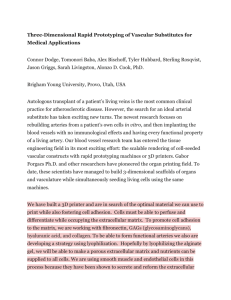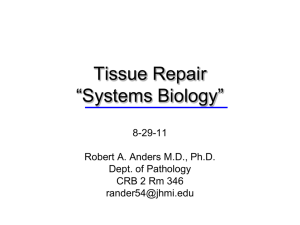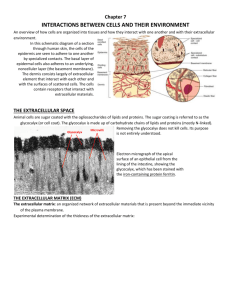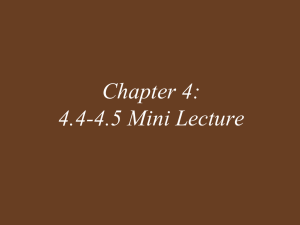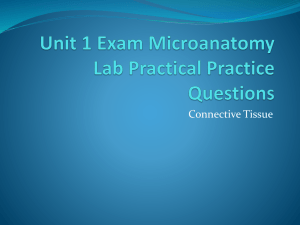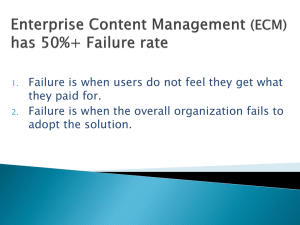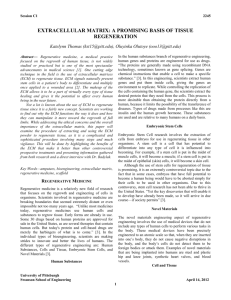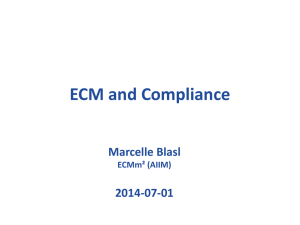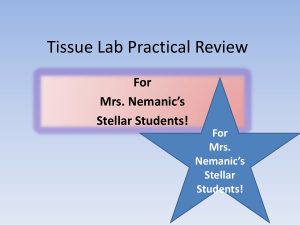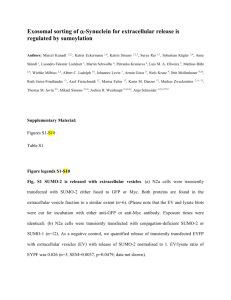File
advertisement
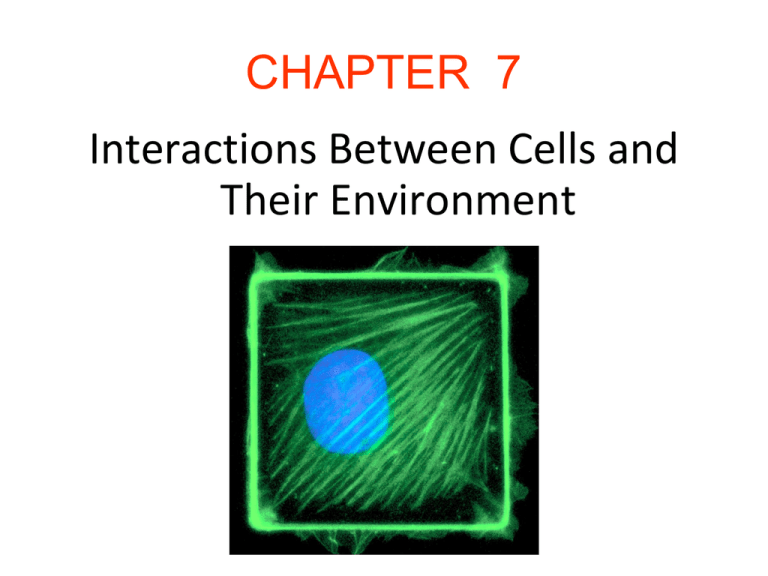
CHAPTER 7 Interactions Between Cells and Their Environment Introduction • Cells interact with extracellular material to form defined tissues. • These interactions are crucial to the formation of epithelial tissue and connective tissue, which are crucial for various cellular activities. Overview of cell organization into tissues 7.1 The Extracellular Space (1) • The glycocalyx (cell coat) is formed from carbohydrate projections form the plasma membrane. • Glycocalyx mediates cell-cell and cellsubstratum interactions. The Extracellular Space (2) • The extracellular matrix (ECM) is an organized network beyond the plasma membrane. – It often plays a regulatory role in determining shape and activities of the cell. The Extracellular Space (3) • ECM (continued) – The basement membrane (basal lamina) is a continuous sheet that underlies epithelial tissue and surrounds blood vessels. • Helps maintain cells attached. • Serves as substratum for cell migration. • Forms a barrier to macromolecules. The basement membrane Organization of the ECM The Extracellular Space (4) • Collagens – fibrous glycoproteins found only in the ECM. – Collagen is the most abundant protein in the human body. – Provide high tensile strength. – Each collage is restricted to particular locations in the body. – All collagens are a trimer of polypeptide chains wound around each other. The structure of collagen I The Extracellular Space (5) • Collagens (continued) – Provide the insoluble framework that determines mechanical properties of the matrix. – Abnormalities in collagen formation lead to serious disorders. The Extracellular Space (6) • Not all collagens form fibrils. • Collagen type IV is non-fibrillar, and is restricted to the basement membrane. The Extracellular Space (7) • Proteoglycans – protein-polysaccharide complex, with a the core protein attached to glycosaminoglycans (GAGs). – Have a repeating disaccharide structure. – Negatively charged GAGs attract lots of cations, which in turn attract water forming a porous, hydrated gel. Structure of a proteoglycna complex Structure of a proteoglycna complex The Extracellular Space (8) • Fibronectin (Fn) – a linear array of distinct polypeptides giving it a modular structure. – Each polypeptide is about 30 Fn modules. – Fn modules are found in other proteins too. – Fn has binding sites for other components of the ECM. – Fn guides migrating cells during embryogenesis. Structure of fibronectin Structure of fibronectin Cell migration during embryogenesis The Extracellular Space (9) • Laminins – extracellular glycoproteins consisting of three polypeptide chains linked by disulfide bonds. – Help cell migration during development. – Components of basement membranes. The Extracellular Space (10) • Dynamic Properties – The ECM can be stretched during tension. – ECM materials degraded by matrix metalloproteinases (MMPs). – MMPs possibly involved in tissue remodeling, embryonic cell migration, wound healing , and formation of blood vessels. 7.2 Interactions of Cells with Extracellular Materials (1) • Integrins – family of membrane proteins composed of heterodimers with α and ß subunits. – Have a major role in integrating extracellular and intracellular environments. – Another role is adhesion of cells to their substratum or other cells. Model of integrin activation Interactions of Cells with Extracellular Materials (2) • Integrins (continued) – Linkage between integrins and their ligands mediates adhesion between cells and their environment. – Binding of proteins to integrins is facilitated by tripeptide RGD. Interactions of Cells with Extracellular Materials (3) Interactions of Cells with Extracellular Materials (4) • Integrins (continued) – Cytoplasmic domains of integrins contain binding sites for a variety of cytoplasmic proteins. – Integrins make the connection between the ECM and the cytoskeleton. Interactions of Cells with Extracellular Materials (5) • Focal adhesions – scattered, discrete sites for cell adhesion to their substratum in vitro. – They may act as a type of sensory structure. – Are also implicated in cell locomotion. Focal adhesions Focal adhesions Forces exerted by focal adhesions Interactions of Cells with Extracellular Materials (6) • Hemidesmosomes – basal attachments of epithelial cells to the basement membrane in vivo. – Contain a dense plaque with filaments consisting of keratin. – Keratin filaments are linked to the ECM by membrane-spanning integrins. Hemidesmosomes 7.3 Interaction of Cells with Other Cells (1) • Cells have surfacerecognition sites that maintain organization Interaction of Cells with Other Cells (2) • Selectins – family of integral membrane glycoproteins that bind to sugars on the surface of cells. Interaction of Cells with Other Cells (3) • Selectins (continued) – Contain a small cytoplasmic domain, a single membrane-spanning domain, and a large extracellular segment. – Three types: • E-selectin – on endothelial cells. • P-selectin – on platelets and endothelial cells. • L-selectin – on white blood cells. Interaction of Cells with Other Cells (4) • Immunoglobulin superfamily (IgSF) – most proteins are involved in immune functions. – Most IgSF molecules mediate interaction of lymphocytes with cells required or immune response.
